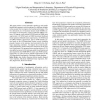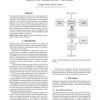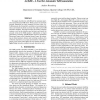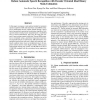INTERSPEECH
2010
13 years 7 months ago
2010
Most paralinguistic analysis tasks are lacking agreed-upon evaluation procedures and comparability, in contrast to more `traditional' disciplines in speech analysis. The INTE...
INTERSPEECH
2010
13 years 7 months ago
2010
This paper presents a novel automatic speaker age and gender identification approach which combines five different methods at the acoustic level to improve the baseline performanc...
INTERSPEECH
2010
13 years 7 months ago
2010
This paper presents a comparison between a hidden Markov model (HMM) based method and a novel artificial neural network (ANN) based method for lip synchronisation. Both model type...
INTERSPEECH
2010
13 years 7 months ago
2010
Text-to-speech synthesizer systems are of overall good quality, especially when adapted to a specific task. Given this task and an adapted voice corpus, the message quality is mai...
INTERSPEECH
2010
13 years 7 months ago
2010
This paper discusses a set of modifications regarding the use of the Bayesian Information Criterion (BIC) for the speaker diarization task. We focus on the specific variant of the...
INTERSPEECH
2010
13 years 7 months ago
2010
This paper describes the AuToBI tool for automatic generation of hypothesized ToBI labels. While research on automatic prosodic annotation has been conducted for many years, AuToB...
INTERSPEECH
2010
13 years 7 months ago
2010
This paper presents our latest efforts toward LVCSR systems for five Eastern European languages such as Bulgarian, Croatian, Czech, Polish, and Russian using our Rapid Language Ad...
INTERSPEECH
2010
13 years 7 months ago
2010
In this paper, we propose a joint optimal method for automatic speech recognition (ASR) and ideal binary mask (IBM) estimation in transformed into the cepstral domain through a ne...
INTERSPEECH
2010
13 years 7 months ago
2010
This paper presents a study on the acoustic sub-segmental properties of word-final /t/ in conversational standard Dutch and how these properties contribute to whether humans and a...
INTERSPEECH
2010
13 years 7 months ago
2010
This paper explores conversational grunts in a face-to-face setting. The study investigates the prosody and turn-taking effect of fillers and feedback tokens that has been annotat...




